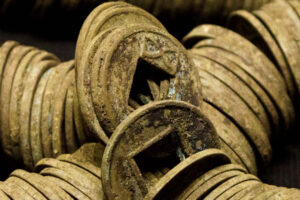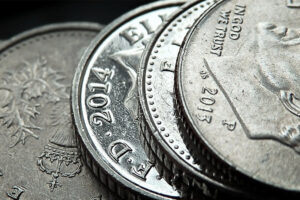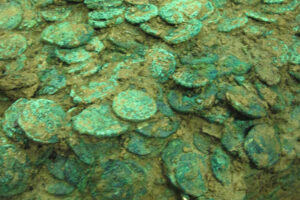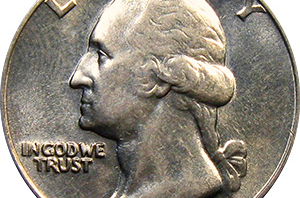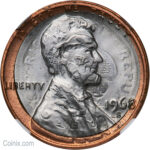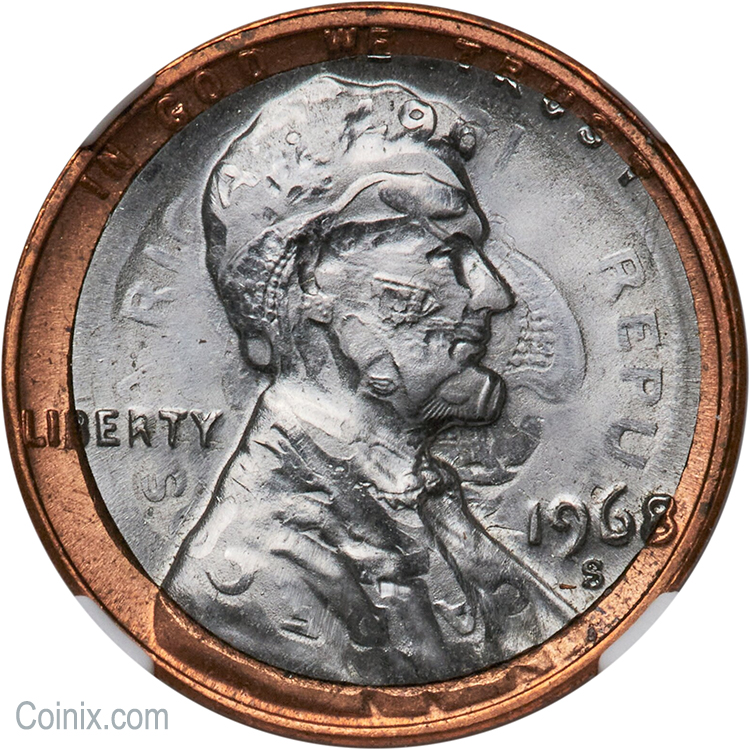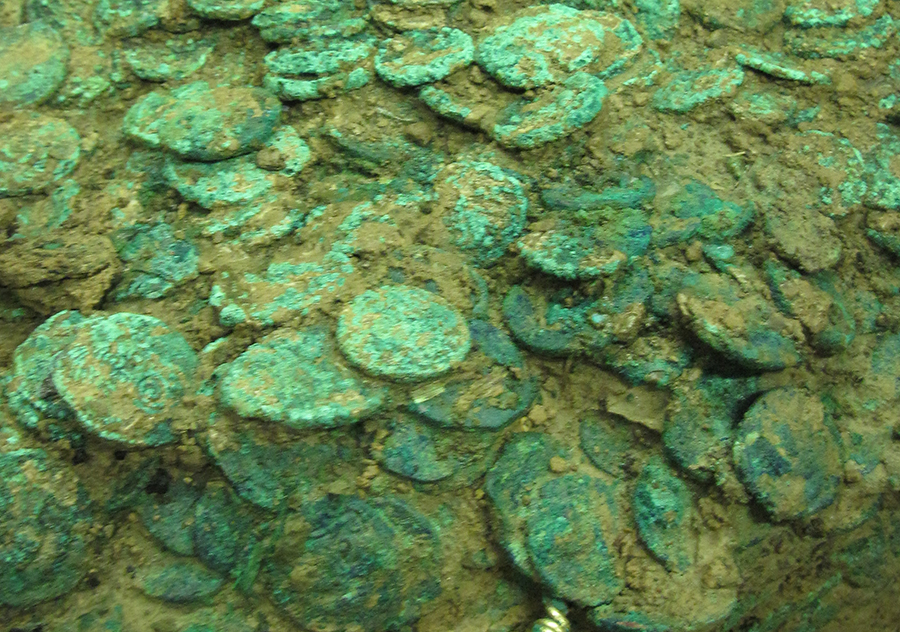The 1965 quarter is a 25-cent coin issued by the United States Mint as part of the Washington quarter series. The Washington quarter, first minted in 1932, features the profile of President George Washington on the obverse side, designed by sculptor John Flanagan. According to CoinTrackers this coin is worth between $1-$35.00 based on condition.

The 1965 quarter is significant because it marks a change in the composition of U.S. quarters. Prior to 1965, quarters were made of 90% silver and 10% copper, often referred to as “silver quarters.” However, due to a growing demand for silver and rising costs, the Coinage Act of 1965 was passed, which altered the composition of quarters, dimes, and half dollars. The new “clad” coinage replaced the silver content with a copper-nickel clad composition.
The 1965 quarter consists of an outer layer made of 75% copper and 25% nickel, bonded to a core of pure copper. This change in composition gives the 1965 quarter a slightly different appearance from its predecessors, with a copper-colored edge visible when viewed from the side.
While the 1965 quarter is not particularly rare or valuable in circulated condition, it is an important piece of U.S. coinage history due to the shift in its metal content. Uncirculated or proof versions of the coin in excellent condition can still be of interest to collectors.
Price Per Grade
- Good (G-4): $0.25 – $0.50
- Very Good (VG-8): $0.50 – $1.00
- Fine (F-12): $1.00 – $1.50
- Very Fine (VF-20): $1.50 – $2.00
- Extremely Fine (EF-40/XF-40): $2.00 – $2.50
- About Uncirculated (AU-50): $2.50 – $3.00
- Uncirculated (MS-60): $3.00 – $6.00
- Choice Uncirculated (MS-63): $7.00 – $15.00
- Gem Uncirculated (MS-65): $15.00 – $35.00
- Superb Gem Uncirculated (MS-67): $32.00 – $50.00 or higher
Is My 1965 Quarter 90% Silver?
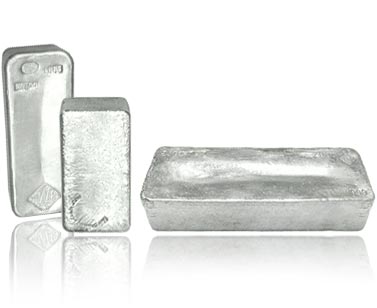
The vast majority of 1965 quarters are not silver; they are made of a copper-nickel clad composition, as introduced by the Coinage Act of 1965. However, some rare silver quarters from 1965 may exist as transitional errors or “wrong metal” strikes. To determine if a 1965 quarter is silver, you can use the following methods:
- Check the edge: A quick and easy way to determine if a 1965 quarter is silver is by examining its edge. Copper-nickel clad quarters have a noticeable copper-colored stripe along the edge, as their core is primarily composed of copper. If the edge of the quarter is uniformly silver without any copper-colored stripe, it might be a silver quarter.
- Weight test: Silver quarters weigh more than copper-nickel clad quarters. A silver quarter from the pre-1965 era typically weighs 6.25 grams, while a copper-nickel clad quarter weighs 5.67 grams. Using a precise scale, you can compare the weight of the 1965 quarter in question to these standard weights. If the weight is closer to 6.25 grams, it could be a silver quarter.
- Tapping test: Gently tapping the quarter with another coin or a metallic object can give you a clue about its composition. Silver quarters produce a distinctive, high-pitched ringing sound, while copper-nickel clad quarters generate a duller, lower-pitched sound.
- Conductivity test: Silver and copper-nickel clad coins have different levels of electrical conductivity. If you have access to a device that can measure electrical conductivity, such as a coin analyzer or a specific type of metal detector, you can use it to determine the coin’s composition.
- Seek professional assistance: If you are still unsure of the quarter’s composition, consider taking it to a reputable coin dealer or submitting it to a professional grading service like the Professional Coin Grading Service (PCGS) or the Numismatic Guaranty Corporation (NGC). These experts can help you authenticate and evaluate the coin.
Please note that silver 1965 quarters are exceedingly rare, so the likelihood of finding one is very low. However, if you do suspect that you have a silver 1965 quarter, it is worth investigating further, as such a coin could hold significant numismatic value.
1965 Quarter Errors



- Doubled Die Obverse (DDO): A doubled die error occurs when the die used to strike the coin has been unintentionally doubled, resulting in a doubled image on the coin. In the case of the 1965 quarter, a doubled die obverse error may manifest as doubled lettering or doubling of certain elements in George Washington’s portrait. This error can increase the value of the coin, depending on the severity of the doubling and the coin’s condition.
- Clipped Planchet: During the minting process, metal strips are punched out to create coin blanks or planchets. Occasionally, the punching process can overlap, resulting in a planchet with a straight or curved clip on its edge. A clipped planchet error on a 1965 quarter can be an interesting addition to a collection and may carry a premium, depending on the size and location of the clip.
- Off-center Strikes: An off-center strike occurs when a coin is not properly aligned with the dies during the striking process. This results in a coin with an off-center design, where part of the design may be missing or distorted. Off-center errors on 1965 quarters can range from minor to major misalignments, and their value typically increases with the severity of the off-center strike.
- Wrong Metal Strikes: As mentioned earlier, the 1965 quarter was meant to be composed of a copper-nickel clad composition. However, there is a possibility that a few rare 1965 quarters were struck on silver planchets left over from 1964. These silver 1965 quarters are considered extremely rare and can carry a significant premium due to their rarity and unusual composition.
- Die Breaks and Cuds: Die breaks occur when a portion of the die used to strike the coin breaks or cracks. This can result in raised lines or blobs on the coin’s surface. A “cud” error occurs when a larger piece of the die breaks off, leaving a raised, unstruck area on the coin. Die breaks and cuds on 1965 quarters can be fascinating errors that may add value to the coin, depending on the size and location of the die break or cud.


